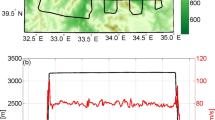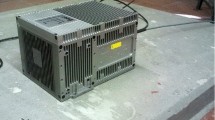Abstract
Airborne gravimetry with strapdown inertial sensors has been a valuable tool for many years to fill in the gravity data gaps on the areas not accessible by land. Accuracies of 1 mGal level with off-the-shelf navigation-grade inertial measurement units (IMU) can only be achieved provided that the accelerometer drifts mainly caused by the temperature variations inside the IMU housing are separated from the gravity signal. Although there are several strategies proposed in the literature to deal with this inseparability problem, we use a thermal stabilization system (iTempStab) added on an iNAT-RQH navigation-grade IMU and investigate its performance over a test region in central Turkey with moderate topography and highly qualified ground truth gravity data. Two test flights were performed in 2017 and 2018 with and without iTempStab add-on following almost the same flight trajectories. During the first flight in 2017 with iNAT-RQH only, which lasted almost 5.5 h, there were considerable temperature variations inside the IMU housing from 39.1 to 46.0 °C. A simple thermal correction based on a laboratory calibration done before the flight was applied to the vertical Z-accelerometer in the pre-processing stage. However, temperature changes were within 0.1 °C during the second test flight in 2018 with TempStab add-on. The temperature stabilization gained by the iTempStab add-on produced better cross-over statistics. While the RMSE of the non-adjusted cross-over residuals was about 2.6 mGal, it reduced by 50% with iTempStab add-on. The adjusted cross-over differences of the 2018 flight yielded an RMSE of about 0.5 mGal, which is a remarkable precision for the strapdown gravimetry. The comparison with upward continued ground gravity data at flight altitudes suggests that the thermal stabilization system shows also remarkable improvements in the residual statistics. The range of the residuals decreases from ± 10 to ± 5 mGal, the standard deviation decreases from 2.19 to 0.94 mGal, and the RMSE decreases from 2.24 to 1.48 mGal, respectively, with the iTempStab add-on. It can be concluded that the thermal stabilization system significantly improves the accelerometer stability and therefore the precision and accuracy of the strapdown airborne gravity estimates.









Similar content being viewed by others
Data availability
The data that support the findings of this study are owned by the Ministry of National Defense, General Directorate of Mapping, Turkey. Authors are not authorized to share the data with third parties. To access the data, contact the General Directorate of Mapping at gdm@harita.gov.tr.
References
Ayres-Sampaio D, Deurloo R, Bos M, Magalhães A, Bastos L (2015) A comparison between three IMUs for strapdown airborne gravimetry. Surv Geophys 36(4):571–586. https://doi.org/10.1007/s10712-015-9323-5
Becker D (2016) Advanced calibration methods for strapdown airborne gravimetry. Ph.D. Thesis, Technische Universität Darmstadt, Darmstadt, Germany. https://tuprints.ulb.tu-darmstadt.de/5691/. Accessed 28 Oct 2019
Becker D, Nielsen JE, Ayres-Sampaio D, Forsberg R, Becker M, Bastos L (2015) Drift reduction in strapdown airborne gravimetry using a simple thermal correction. J Geod 89:1133–1144. https://doi.org/10.1007/s00190-015-0839-8
Bruton AM, Schwarz KP, Ferguson S, Kern M, Wei M (2002) Deriving acceleration from DGPS: toward higher resolution applications of airborne gravimetry. GPS Solut 5(3):1–14. https://doi.org/10.1007/PL00012894
Deurloo RA (2011) Development of a Kalman filter integrating system and measurement models for a low-cost strapdown airborne gravimetry system. Ph.D. Thesis, Faculty of Sciences, University of Porto, Porto, Portugal
Deurloo R, Yan W, Bos M, Ayres-Sampaio D, Magalhães A, Becker M, Becker D, Bastos L (2015) A comparison of the performance of medium-and high-quality inertial systems grades for strapdown airborne gravimetry. In: Rizos C, Willis P (eds) IAG 150 years. International association of geodesy symposia, vol 143. Springer, Cham, pp 323–329. https://doi.org/10.1007/1345_2015_18
Forsberg R (1984) A study of terrain reductions, density anomalies and geophysical inversion methods in gravity field modeling. Report no. 355, Department of Geodetic Science and Surveying, The Ohio State University, Columbus, USA. https://earthsciences.osu.edu/geodetic/resources/osu-reports. Accessed 28 Oct 2019
Forsberg R, Olesen AV (2010) Airborne gravity field determination. In: Xu G (eds) Sciences of geodesy-I. Springer, Berlin Heidelberg, pp 83–104. https://doi.org/10.1007/978-3-642-11741-1_3
Forsberg R., Tscherning CC (2008) An overview manual for the GRAVSOFT geodetic gravity field modelling programs. Technical Report, Danish Space Center, Technical University of Denmark, Lyngby, Denmark
Forsberg R, Olesen AV, Keller K, Møller M, Gidskehaug A, Solheim D (2001) Airborne gravity and geoid surveys in the Arctic and Baltic Seas. In: Proceedings of international symposium on kinematic systems in geodesy, Geomatics and Navigation (KIS-2001), Banff, pp 586–593
Gelb A (1974) Applied optimal estimation. The M.I.T Press, Cambridge. ISBN 0-262-20027-9
Glennie C, Schwarz KP (1999) A comparison and analysis of airborne gravimetry results from two strapdown inertial/DGPS systems. J Geod 73(6):311–321. https://doi.org/10.1007/s001900050248
Glennie CL, Schwarz KP, Bruton AM, Forsberg R, Olesen AV, Keller K (2000) A comparison of stable platform and strapdown airborne gravity. J Geod 74(5):383–389. https://doi.org/10.1007/s001900000082
Groves PD (2013) Principles of GNSS, inertial, and multisensor integrated navigation systems, 2nd edn. Artech House, Boston, MA, USA, London, UK. ISBN 978-1-60807-005-3
Heiskanen WA, Moritz H (1967) Physical geodesy. WH Freeman and Company, San Francisco, CA, USA
Hirt C, Kuhn M, Claessens S, Pail R, Seitz K, Gruber T (2014) Study of the earth’s short-scale gravity field using the ERTM2160 gravity model. Comput Geosci 73:71–80. https://doi.org/10.1016/j.cageo.2014.09.001
Hwang C, Hsiao Y-S, Shih H-C (2006) Data reduction in scalar airborne gravimetry: theory, software and case study in Taiwan. Comput Geosci 32(10):1573–1584. https://doi.org/10.1016/j.cageo.2006.02.015
Jekeli C (1994) Airborne vector gravimetry using precise, position-aided inertial measurement units. Bulletin géodésique 69(1):1–11. https://doi.org/10.1007/BF00807986
Jekeli C, Kwon JH (1999) Results of airborne vector (3-d) gravimetry. Geophys Res Lett 26(23):3533–3536. https://doi.org/10.1029/1999GL010830
Jensen TE (2018) Airborne strapdown gravity measurements for geodesy and geophysics. Ph.D. Thesis, Kgs. Lyngby: Technical University of Denmark. https://orbit.dtu.dk/ws/files/164587031/Main.pdf. Accessed 28 Oct 2019
Jensen TE, Forsberg R (2018) Helicopter test of a strapdown airborne gravimetry system. Sensors 18(9):3121. https://doi.org/10.3390/s18093121
Jensen TE, Olesen AV, Forsberg R, Olsson PA, Josefsson Ö (2019) New results from strapdown airborne gravimetry using temperature stabilisation. Remote Sens 11(22):2682. https://doi.org/10.3390/rs11222682
Kaas E, Sørensen B, Tscherning CC, Veicherts M (2013) Multi-processing least squares collocation: applications to gravity field analysis. J Geod Sci 3(3):219–223. https://doi.org/10.2478/jogs-2013-0025
Kvas A, Mayer-Gürr T, Krauss S, Brockmann JM, Schubert T, Schuh W-D, Pail R, Gruber T, Jäggi A, Meyer U (2019) The satellite-only gravity field model GOCO06s. Paper presented at EGU General Assembly 2019, Vienna, Austria. 10.13140/RG.2.2.14101.99047
Kwon JH, Jekeli C (2001) A new approach for airborne vector gravimetry using GPS/INS. J Geod 74(10):690–700. https://doi.org/10.1007/s001900000130
Moritz H (2000) Geodetic reference system 1980. J Geod 74(1):128–133. https://doi.org/10.1007/s001900050278
Rauch HE, Striebel CT, Tung F (1965) Maximum likelihood estimates of linear dynamic systems. AIAA J 3(8):1445–1450. https://doi.org/10.2514/3.3166
Sampietro D, Capponi M, Mans AH, Gatti A, Marchetti P, Sansò F (2017) Space-Wise approach for airborne gravity data modelling. J Geod 91:535–545. https://doi.org/10.1007/s00190-016-0981-y
Schwarz KP, Wei M (1990) A framework for modelling kinematic measurements in gravity field applications. J Geod 64(4):331–346. https://doi.org/10.1007/BF02538407
Schwarz KP, Colombo O, Hein G, Knickmeyer ET (1992) Requirements for airborne vector gravimetry. In: Colombo OL (eds) From mars to greenland: charting gravity with space and airborne ınstruments. International Association of Geodesy Symposia, vol 110. Springer, New York, NY. https://doi.org/10.1007/978-1-4613-9255-2_25
Simav M, Yildiz H (2019) Evaluation of EGM2008 and latest GOCE-based satellite only global gravity field models using densified gravity network: a case study in south-western Turkey. Bollettino di Geofisica Teorica ed Applicata 60(1):49–68. https://doi.org/10.4430/bgta0255
Tomé P (2002) Integration of inertial and satellite navigation systems for aircraft attitude determination. Ph.D. dissertation, Faculty of Sciences, University of Porto, Porto, Portugal
Wei M, Schwarz KP (1998) Flight test results from a strapdown airborne gravity system. J Geod 72(6):323–332. https://doi.org/10.1007/s001900050171
Acknowledgements
This work is a part of the Turkish Height System Modernization and Gravity Recovery Project supported by the Presidency of Turkey, Directorate of Strategy and Budget and coordinated by the General Directorate of Mapping. We would like to give our sincere thanks to TÜBİTAK National Metrology Institute in Gebze for their valuable contribution during the procurement of iNAT-RQH and iTempStab.
Author information
Authors and Affiliations
Contributions
All the authors contributed to the design of the study and came up with the idea of the research. MS processed the SIMU and GNSS data with the help of DB. HY performed upward continuation of terrestrial gravity data. MH is the project manager of iTempStab. MS drafted the manuscript. All authors read and approved the final manuscript.
Corresponding author
Rights and permissions
About this article
Cite this article
Simav, M., Becker, D., Yildiz, H. et al. Impact of temperature stabilization on the strapdown airborne gravimetry: a case study in Central Turkey. J Geod 94, 41 (2020). https://doi.org/10.1007/s00190-020-01369-5
Received:
Accepted:
Published:
DOI: https://doi.org/10.1007/s00190-020-01369-5




